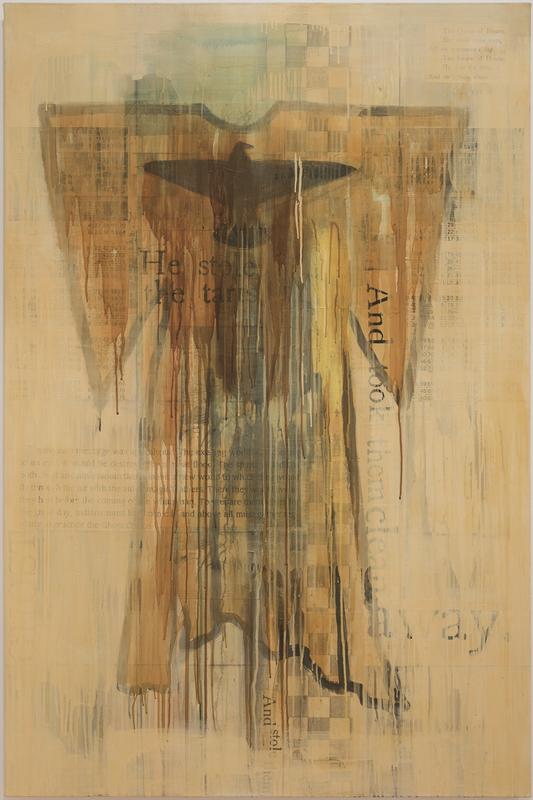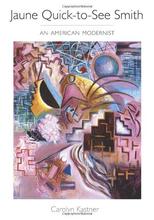More about Ghost Dance Dress
- All
- Info
- Shop

Contributor
Jaune Quick-to-See Smith’s Ghost Dance Dress depicts the type of dress worn by Native American women during Ghost Dances.
The Ghost Dance itself is usually credited to Tävibo and dated in 1869. Tävibo is a Northern Paiute. He prophesied that white people would disappear from society for their travesties, and deceased Native Americans would return from the dead. The dance had a few different purposes, perhaps the most important and obvious being that the dance was one of communication with the dead, hence the name “Ghost Dance.” Another intention of the dance was to invoke a natural disaster that would sweep away white people. The third intention, going hand-in-hand with the natural disaster was that the dance would bring massive herds of buffalo and prosperity.
The Ghost Dance and its prophecies offered much hope to Native Americans who were largely suffering at the hands of United States violence and treatment. It spread as far west as California, then reportedly disappeared over time as the prophecies didn’t come into fruition. In 1890, Tävibo’s son Wovoka brought the Ghost Dance back. It was adopted widely by the Lakotas and their leader Sitting Bull. White America responded nastily through the government and the press in articles like The Ghost Dance in the New York Times which condemned the dance in a racist rant. White neighbors to the Lakotas and U.S. reservation officials believed the dance was one of violence and spread word that it was a war dance. The U.S. government tried to outlaw the Lakotas from the dance, and then the U.S. army demanded the arrest of Sitting Bull. Sitting Bull was killed in the arrest. Two weeks later, the U.S.’s seventh cavalry killed over 300 Lakotas in the Wounded Knee Massacre.
The Ghost Dance largely died out after this, though it did survive around the Plains. It resurfaced again at the site of the Wounded Knee in the 1970s when Leonard Crow Dog, an Oglala Lakota, revived it as an act of protest as a part of the Red Power movement. Around this time, the Institute of American Indian Arts was established, and Native American artists became fascinated with the Ghost Dance for its nature of protest. This was foundational in many ways to the movement of “Indian Protest Art.”
Depicted in Smith’s painting is a Ghost Dance dress. Native American women and their dresses are themes she returns to often in her work. The Ghost Dance dresses were painted with “charged symbols of nature and feminine identity.” Common symbols include the thunderbird and new moon, which symbolize a new beginning. Other common symbols like the turtle and the morning star symbolize the protection of women and a long life.
The prophecies around the Ghost Dance gave hope to homeless, ill, and hungry Native Americans at the time, and Smith tries to capture that essence not just with the dress, but also with the phrases and images collaged behind it. There’s the eagle (a messenger of prophecy), bingo cards (representing the Catholic introduction of gambling to reservations), and the Queen of Hearts nursery rhyme (a haunting little rhyme about stealing and promising not to steal).
In reference to her own work and to the rising number of Native American artists enrolling in universities, Smith said, “With a university training, you’re exposed to classic art and traditions from around the world. You wouldn’t be true to yourself if you didn’t incorporate what you were familiar with...Contemporary native people, including myself, are doing the same thing that Pollock and Newman did in taking images from native cultures.” She also points out how despite all of this brilliant abstract expressionism, people pay more attention when the abstract expressionists are white.
Sources
- ARTnews, T. (1992, November). From the Archives: Native American Artists Ponder History and Visibility, in 1992. Retrieved July 31, 2020, from https://www.artnews.com/art-news/retrospective/archives-native-american…
- Brooklynmuseum. (2018, October 08). Brooklynmuseum. Retrieved July 31, 2020, from https://brooklynmuseum.tumblr.com/post/178852620915/jaune-quick-to-see-… Ghost Dance Dress. (n.d.). Retrieved July 31, 2020, from https://www.brookl
- The Ghost Dance. (1890, November 22). Retrieved July 31, 2020, from https://timesmachine.nytimes.com/timesmachine/1890/11/22/issue.html
- Huck, T. (2020, March 23). The Beauty and Meaning of Ghost Dance Shirts. Retrieved July 31, 2020, from https://terrijhuck.com/2017/02/02/ghost-dance-shirts/
- Jaune Quick-to-See Smith Featured in Artnews. (2018, November 30). Retrieved July 31, 2020, from https://www.garthgreenan.com/news/jaune-quick-to-see-smith-featured-in-…
- Kerstetter, T. M. (n.d.). Encyclopedia of the Great Plains. Retrieved July 31, 2020, from http://plainshumanities.unl.edu/encyclopedia/doc/egp.rel.023













I wonder what kinds of mythologies are related like this maybe? https://www.sartle.com/artwork/the-night-hag-visiting-lapland-witches-h…